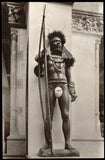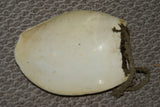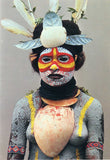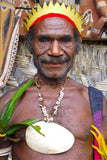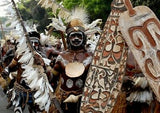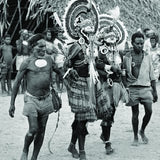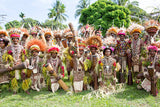Bilas Baler Melomelo or Mero Amphora, Prestigious Male Ornament: Groin Penile Cover “Gam” or Pectoral Display, owned by Tribal Chief Warrior, Also Mendi Exchange Currency, BAL8. Collected in late 20th Century, Gulf of Carpentaria, New Guinea. 9"x 8"
Bilas, baler, bailer, Gam, melo melo, melomelo.
UNIQUE, HUGE AND RARE PECTORAL ORNAMENT OR PENIS PROTECTIVE COVER. MELO AMFOLA, AMPHORA.
These Bailer Shells are the most prestigious male ornaments in the Southern Highlands, valued much above anything else.
Such decorative items were only worn by the “Big Men”, the initiated men and the Shamans of Papua New Guinea during special ceremonies & rites, either as a pectoral ornament or as a groin covering. (A similar collector piece was featured at the exhibition "The Art of Papouans" at the Museum” La Charité” in Marseilles – France).
This is a Huge & Old Warrior Baler (bailer) shell, called “Gam”: A Prestigious Male ornament with multiple uses as a powerful pectoral display, as a penis groin protective covering, with a currency value (used for bride price or payments after war or feuds) & also to bale water out of leaking canoes because these shells are very large & deep, some of the largest in existence.
An item of great value to the natives since there are no shells in the highlands of PNG and they had to be acquired through trade with people from the lower regions.
Such a valuable ornament was used during Sing-Sing ceremonies and festivals, rites of passage, initiations, either as a pectoral decoration or as a penis cover as seen on the photos.
Gulf of Carpentaria, Mendi valley, Papua New Guinea. PNG HIGHLANDS.
ITEM BAL8, HUGE & VERY RARE: 9 X 7 1/2" X 2"
As seen in museum collections or exhibitions.
This shell has a whitish patina showing age and use, and is very large.
The baler shell is called locally “Melomelo”. This one has remaining attachments on each side created with twisted bark fiber, and was once used as a groin cover as seen on some of the photos (Another local name for it is Mero Amfola). It could also sometimes be worn as a powerful chest statement as seen on some of the photos as well. Such rare large pieces were originally found on the beaches of the Gulf of Carpentaria.
You see "Big Men" wearing them on some of my photos.
In traditional times, Such an item likely made its way from the Papuan Gulf into the interior of the Peninsula through trade. Such shells are very important in the traditional tribal industry, if you can call it such. The relatively flat surface near the lip of the shell can be cut into a woomera. It has many uses besides being worn as a body ornament or penis protection, some being: as currency (in certain areas of New Guinea, bailer shells were used as bride price), as a general container, similar to a cup or coolamon, for carrying water or sugarbag honey (Water can be boiled in the shell by placing it directly on the hot coals in the fire and in the coastal villages and along the rivers, to bail water out of canoes as some of those shells are very large, as this one is.
Artistic expression in the Highlands is conveyed largely through body art. Diverse in both media and application, the major components of Highlands body ornamentation include bird of paradise plumes, body paint, and an enormous variety of decorative objects made from shell, teeth, beetles, orchid stem, fur, bone, bark, wood, and fiber. (Moriarty recognized the importance of this art and its central position in the broader context of Highlands art. A visionary in any age, he not only developed a unique collection of body decoration from the Highlands of New Guinea, but saw to it that this collection remained intact by donating it to the AGNSW. Today it is part of what is possibly the world's most important accumulation of this art.)
All our collector and rare items come with pages and pages of research about provenance, and with history of the tribes and photos as well, depending on item and whenever possible. When shipping internationally, we group ship multiple purchases to save you money, and find the best rates available. If you have any questions or want to see research conducted on this piece and photos of tribes, let us know.





























